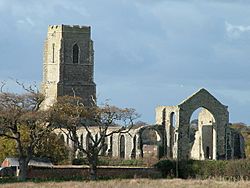St Andrew's Church, Covehithe facts for kids
Quick facts for kids St Andrew's Church, Covehithe |
|
|---|---|

St Andrew's Church, Covehithe
|
|
| Lua error in Module:Location_map at line 420: attempt to index field 'wikibase' (a nil value). | |
| OS grid reference | TM 523 818 |
| Location | Covehithe, Suffolk |
| Country | England |
| Denomination | Anglican |
| Website | Churches Conservation Trust St Andrew, Covehithe |
| History | |
| Dedication | Saint Andrew |
| Architecture | |
| Heritage designation | Grade I |
| Designated | 27 November 1954 |
| Architectural type | Church |
| Style | Gothic |
| Administration | |
| Parish | Covehithe with Benacre |
| Deanery | Halesworth |
| Archdeaconry | Suffolk |
| Diocese | St Edmundsbury and Ipswich |
| Province | Canterbury |
St Andrew's Church is an old Anglican church in a small village called Covehithe in Suffolk, England. Part of this church is in ruins, but it's still a very important building. It's listed as a Grade I historic building, which means it's super special! The ruined parts are looked after by the Churches Conservation Trust. This church is right by the sea, in an area where the coast is slowly wearing away. The church parish of Covehithe is now joined with the nearby village of Benacre.
Contents
Church History
The original large church was built a long time ago, mostly in the 14th and 15th centuries. That's over 600 years ago! During the English Civil War, a person named William Dowsing destroyed much of the church's beautiful stained glass windows. He was an iconoclast, meaning he believed religious images should be removed.
Later, the big church became too expensive for the local people to take care of. So, in 1672, they got permission to remove the roof. They then built a much smaller church inside the old one. This smaller church is still used today. The tall tower and the ruined walls of the original church are now cared for by the Churches Conservation Trust.
The Church Today
The church parish is part of The Prayer Book Society. This group supports using the traditional Book of Common Prayer. Because the church does not agree with the ordination of women as priests, it gets special support. This support comes from the Bishop of Richborough, who is currently Norman Banks.
Church Design and Architecture
The church shows two different building styles because it was built at different times.
The Medieval Church Design
The oldest part of the church is made from rough flint stones and has stone decorations. It had a nave (the main part), a chancel (the area around the altar), and long aisles on both sides. There was also a small room called a sacristy and a tall tower at the west end.
The tower is still standing and has three main sections. It has strong buttresses (supports) and a battlemented top, like a castle. In the middle part of the tower, there's a fancy pointed arch opening. The top part has openings for bells on each side, but their stone patterns are gone. The wall of the south aisle is more complete than the north wall. It still has six window openings. The chancel sticks out a bit and has tall window openings. The supports at the east end have cool checkerboard patterns and special niches for statues. Some of the carved stone supports for the chancel roof are still there.
The Newer Small Church Design
The small church built in the 17th century is attached to the old tower. It uses many materials from the older church, and some bricks too. Its roof is made of thatch, which is dried straw or reeds. The windows have two parts, separated by wooden bars, and use diamond-shaped glass pieces. Both the north and south doorways were reused from the old church. The east window was added in the 19th century.
Inside the church, you can see a carved, eight-sided baptismal font from the 15th century. At the back, there are old wooden pews from the 15th century with special carvings called poppyheads. The wooden pulpit (where the priest speaks) has some carvings from the 17th century. Under the arch of the tower, you can see the royal arms of King George III.
Images for kids
See also



